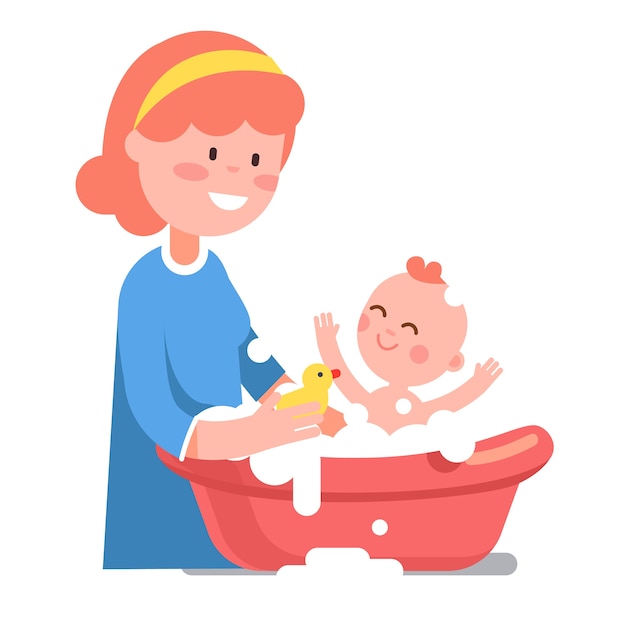
**Bathing Your Newborn Baby: Essential Tips and Steps**
Bathing a newborn can feel a bit intimidating at first, but with the right approach, it can become an enjoyable bonding experience. Most doctors suggest starting with sponge baths using a lukewarm, damp cloth to gently clean your baby’s face, hands, and other parts of the body. Once the umbilical cord stump has fallen off and the area has fully healed, you can move on to using a small tub filled with warm (not hot) water.
During your baby’s first year, it’s best to keep baths infrequent, as excessive bathing can dry out their delicate skin. Warm water is essential to keep your baby comfortable and avoid colds. If your baby starts crying, try to keep the bathing time as short as possible. Always hold your baby securely to prevent accidents.
### Important Safety Notes
– Never leave your baby unattended, even for a moment. If you’re interrupted—whether by a phone call or the doorbell—always bring your baby with you.
– Avoid placing your baby in the tub while water is still running, as the temperature can quickly become too hot or too cold.
– Adjust your water heater to a safe temperature of 120°F. Water at 140°F or higher can cause severe burns in seconds.
– Keep in mind that even a small amount of water (less than an inch) can pose a drowning risk to your baby in just 60 seconds. Always remain present and attentive.
### Step-by-Step Guide to Giving Your Baby a Bath
1. **Get Organized**: Before starting, gather all supplies—mild soap, a washcloth, a plastic cup, clean clothes, a fresh diaper, and a towel. Make sure the room is warm enough to keep your baby comfortable.
2. **Prepare the Water**: Fill the tub with about 3 inches of warm (not hot) water. Test the temperature using the inside of your wrist; it should feel comfortably warm, ideally below 90°F.
3. **Undress Your Baby**: Start by gently removing your baby’s clothes and diaper. If your baby feels unsettled, you can leave the diaper on for an added sense of security until they adjust.
4. **Place Your Baby in the Tub**: Lower your baby into the water, ensuring their feet touch the bottom first. Use one hand to support their neck and head while keeping a firm but gentle grip.
5. **Clean Up Gently**: Use a small amount of mild soap and a soft washcloth—or just your hand—to clean your baby’s body. Limit soap usage to avoid drying out their sensitive skin. Gently clean the scalp and use a damp washcloth to wipe away any dried material near their eyes or nostrils.
6. **Rinse and Dry**: Once finished, pour cups of warm water over your baby’s body to rinse them off. Carefully lift your baby out of the tub, supporting their neck and bottom with your hands, and wrap them in a dry, hooded towel.
7. **Post-Bath Care**: Pat your baby’s skin dry, paying extra attention to creases to avoid irritation from trapped moisture. If the skin appears dry or peeling, apply a mild baby lotion.
### Why Bathing Benefits Your Baby
Bathing isn’t just about keeping your baby clean—it’s also a wonderful opportunity to bond. Spending time together during bath time can strengthen your connection and create lasting memories. Your baby might enjoy splashing the water, playing little games, or simply relaxing in the warm bath. Plus, a soothing bath before bed can help establish a calming nighttime routine to promote better sleep.
### Additional Tips for a Safe and Enjoyable Bath
– **Set a Routine**: Develop a consistent schedule, alternating sponge and tub baths as needed. Bathing in the evening can often help signal bedtime for your baby.
– **Prepare Everything in Advance**: Have all your essentials, like baby-safe soap, shampoo, towels, and diapers, ready before starting the bath.
– **Check the Water Temperature**: Always test the water with the sensitive part of your wrist or elbow to ensure it’s comfortably warm.
– **Handle with Care**: Gently clean each part of your baby’s body, using minimal soap to avoid skin irritation. Always support their head, neck, and back during handling.
Other things to keep in mind: never rub your baby’s skin with a towel; instead, pat it dry to avoid damage. Look for gentle baby products like shampoos and lotions specifically designed for infants to prevent irritation or allergies. Lastly, it’s essential to stay attentive to your baby’s mood—bath time should happen when your baby is relaxed and calm.
By following these simple guidelines, you can make bathing an enjoyable experience for both you and your baby. A clean, well-cared-for infant is a happy one, and this routine can help keep your baby healthy, secure, and comforted.